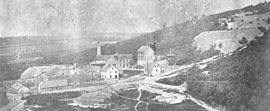Silberhardt mine
| Silberhardt mine | |||
|---|---|---|---|
| General information about the mine | |||
| The old Silberhardt mine | |||
| Information about the mining company | |||
| Employees | 400 | ||
| Start of operation | 13th Century | ||
| End of operation | 1936 | ||
| Funded raw materials | |||
| Degradation of | Silver, lead, iron, zinc, copper | ||
| Greatest depth | 130 m | ||
| Geographical location | |||
| Coordinates | 50 ° 49 '23.3 " N , 7 ° 38' 34.8" E | ||
|
|||
| Location | Öttershagen | ||
| local community | Windeck | ||
| District ( NUTS3 ) | Rhein-Sieg district | ||
| country | State of North Rhine-Westphalia | ||
| Country | Germany | ||
The Silberhardt mine in Öttershagen , a district of Windeck , is a former ore mine that was reopened as a visitor mine on September 13, 2003 .
history
The pit was excavated as early as the 13th century. After the Thirty Years War, the mine was reopened in 1752.
In 1808, Mayor Johann Caspar Rumpe von Altena acquired the abandoned mine. In 1810 he sells it to the butchers' trade , but buys it back after a partial collapse . In 1819, large amounts of silver-bearing galena were mined. The Bröler ironworks was rebuilt for the smelting of lead and silver ore and even expanded in 1824. In 1824 water art was also introduced. In 1825 a stamping mill was built in Rosbach (Sieg) .
In 1831 the Sieg was first examined for contamination. In 1833 there was a workers' uprising and in 1834 production was stopped. After small tradesmen acquired the mine in 1859, mining was stopped again in 1861 and the owner changed hands.
In 1863 the establishment of an AG Silberhardt en Jucht was approved in Amsterdam , in 1873 an AG Ertsdelveriy Amsterdam was established. In 1874 shares with a nominal value of 150,000 guilders were issued. Initially in 1881 and finally in 1882, the mine ceased operations again. In 1884 a Mr. Dahm the 100 Kuxe union Silberhardt , in 1892 the consolidation took place and in 1900 the reopening, but no production. 1914 built a Mr. Flothmann opened a second processing plant, which was forcibly auctioned again in 1915. In 1920 the Thyssen ironworks took over the mine, which was combined with others to form the Eisenberg consolidation . In 1924 a "Mr. Käsgen" took over the processing plant and the mine, but in 1925 had to lay off many employees; In 1926 the property was auctioned off. In 1926, the United Steelworks acquired the mine and produced from 1930 to 1936. In 1953, Erzbergbau Siegerland acquired the mine, and in 1965, Barbara Rohstoffbetriebe .
Visitor mine
In 1997 the opening of the filled Upper New Adit began. In 1999 the first visitors could be brought in. In 2002 the association for the preservation of the mining and smelting tradition eV was founded. In July 2011, the development association was able to open the new visitor and information center.
Mining trail
In 2001, a 1.7 kilometer long and 14 station hiking trail was inaugurated. This touches various tunnel mouth holes , a racing stove and a charcoal pile .
Mining museum
In 2017, the greatly expanded mining history exhibition was reopened. In addition to the history of the Silberhardt mine, issues relating to mining in the Siegerland region and the social situation of the miners are dealt with, and an ore and mineral collection is shown.
Mine train
The first mine locomotive ran in 2000 .
literature
- Harald Patzke: The Silberhardt mine: A visitor mine invites you . Martina Galunder, Nümbrecht 2003, ISBN 3-89909-024-1 .


